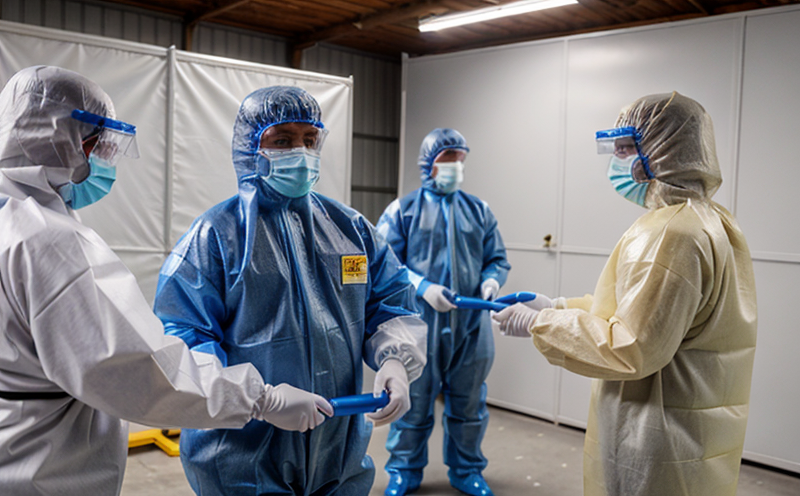ISO 17491 Determination of particle protection in disposable coveralls
The ISO 17491 standard is a pivotal test method used to determine the efficiency with which certain types of protective clothing, specifically disposable coveralls, prevent the ingress of particles. This service plays an essential role in ensuring that workers in high-risk environments are adequately protected against airborne contaminants.
Disposable coveralls are designed for short-term use and typically worn over normal clothing to provide a barrier between the wearer and potential hazards such as infectious agents, chemicals, or other harmful substances. The ISO 17491 test focuses on evaluating how effectively these coveralls can prevent particles from penetrating their surface.
Testing according to ISO 17491 involves exposing the coverall material to a controlled aerosol of particulates and then measuring any penetration through the fabric. This method ensures that protective clothing meets stringent international standards, thereby enhancing workplace safety and compliance with regulatory requirements.
The test setup includes a particle generator that produces an aerosol of known size distribution, typically ranging from 0.3 microns to 10 microns in diameter. The coverall is placed over a standardized port, creating a sealed system where the particles are directed towards the fabric. A detector downstream measures any particles that pass through the material.
The testing process requires careful specimen preparation and handling to ensure accurate results. This includes ensuring the coveralls are clean, undamaged, and properly fitted before testing. Post-testing analysis involves comparing the particle counts upstream of the coverall with those detected downstream. Any increase in particle count indicates potential breaches in protection.
Accurate reporting is critical when conducting ISO 17491 tests. The report should detail the test conditions, including particle size range, concentration, and environmental parameters such as temperature and humidity. It also provides the results of particle penetration through the material, expressed as a percentage or absolute count, along with any relevant acceptance criteria.
The importance of this service cannot be overstated, especially in sectors like healthcare, pharmaceuticals, and manufacturing where worker safety is paramount. By ensuring that protective clothing meets rigorous standards, organizations can help prevent occupational illnesses and injuries associated with exposure to hazardous materials.
- Accurate particle size distribution: Ensuring the test aerosol closely mimics real-world conditions.
- Standardized testing protocols: Following internationally recognized guidelines ensures consistent results across different laboratories.
- Comprehensive reporting: Providing detailed analyses and recommendations for improvements based on test outcomes.
This service is indispensable in maintaining a safe working environment by verifying the protective capabilities of disposable coveralls against airborne particles. It supports compliance with regulatory standards, enhances worker safety, and contributes to overall operational excellence within organizations across various industries.
Industry Applications
The ISO 17491 test is widely applicable in several key sectors:
- Healthcare: Ensures that medical staff are adequately protected against infectious agents and other airborne contaminants.
- Pharmaceuticals: Guarantees the integrity of cleanroom environments, safeguarding product quality and purity.
- Manufacturing: Protects workers from exposure to toxic substances or particulates in various industrial processes.
- Environmental Science: Supports field researchers by providing reliable data on the protective performance of coveralls used in outdoor studies.
In each of these industries, the ISO 17491 test is crucial for maintaining high standards of occupational safety and compliance with regulatory requirements. By ensuring that disposable coveralls meet the specified particle protection criteria, organizations can significantly reduce the risk of workplace hazards.
Customer Impact and Satisfaction
- Enhanced Safety: Organizations benefit from increased employee safety by ensuring that protective clothing effectively prevents particle ingress.
- Regulatory Compliance: Meeting international standards ensures compliance with regulatory bodies, avoiding potential fines or legal issues.
- Improved Reputation: Demonstrating a commitment to worker safety and quality through rigorous testing enhances an organization’s reputation.
- Reduced Risks: By identifying any breaches in protection early on, organizations can take corrective actions to prevent accidents and health risks.
- Cost Savings: Although the initial investment in protective clothing is necessary, ensuring its effectiveness through testing can save costs associated with occupational illnesses or injuries.
- Operational Excellence: Reliable data from ISO 17491 tests support continuous improvement and optimization of safety protocols within organizations.
Customer satisfaction is directly linked to the quality and reliability of protective clothing. By offering this service, we help our clients achieve their goals of maintaining a safe workplace while complying with international standards.
Use Cases and Application Examples
The ISO 17491 test is particularly relevant in several scenarios:
- Hospital Outbreaks: During outbreaks of infectious diseases, ensuring the integrity of protective clothing used by medical staff is crucial.
- Pharmaceutical Manufacturing: Cleanroom environments must maintain strict particulate levels to ensure product quality and purity.
- Hazardous Material Handling: Workers in industries handling toxic or hazardous materials need reliable protection against airborne contaminants.
- Epidemiological Research: Field researchers conducting studies in remote areas often use protective clothing that must meet rigorous standards for particle protection.
In each of these cases, the ISO 17491 test provides critical data on the performance of disposable coveralls. This information is invaluable for decision-making processes related to safety protocols and operational procedures.





